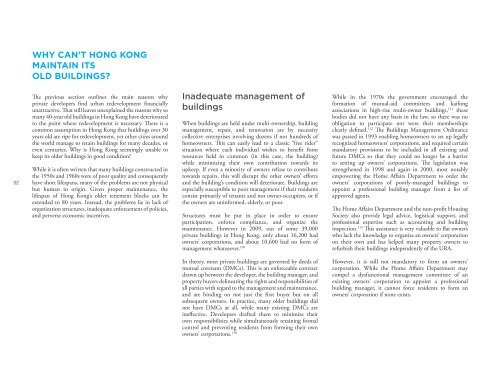Treating the Symptoms - A Critical Review of ... - Civic Exchange
Treating the Symptoms - A Critical Review of ... - Civic Exchange
Treating the Symptoms - A Critical Review of ... - Civic Exchange
- No tags were found...
You also want an ePaper? Increase the reach of your titles
YUMPU automatically turns print PDFs into web optimized ePapers that Google loves.
Why can’t Hong KongMaintain itsOld Buildings?32The previous section outlines <strong>the</strong> main reasons whyprivate developers find urban redevelopment financiallyunattractive. That still leaves unexplained <strong>the</strong> reasons why somany 40-year old buildings in Hong Kong have deterioratedto <strong>the</strong> point where redevelopment is necessary. There is acommon assumption in Hong Kong that buildings over 30years old are ripe for redevelopment, yet o<strong>the</strong>r cities around<strong>the</strong> world manage to retain buildings for many decades, oreven centuries. Why is Hong Kong seemingly unable tokeep its older buildings in good condition?While it is <strong>of</strong>ten written that many buildings constructed in<strong>the</strong> 1950s and 1960s were <strong>of</strong> poor quality and consequentlyhave short lifespans, many <strong>of</strong> <strong>the</strong> problems are not physicalbut human in origin. Given proper maintenance, <strong>the</strong>lifespan <strong>of</strong> Hong Kong’s older tenement blocks can beextended to 80 years. Instead, <strong>the</strong> problems lie in lack <strong>of</strong>organization structures, inadequate enforcement <strong>of</strong> policies,and perverse economic incentives.Inadequate management <strong>of</strong>buildingsWhen buildings are held under multi-ownership, buildingmanagement, repair, and renovation are by necessitycollective enterprises involving dozens if not hundreds <strong>of</strong>homeowners. This can easily lead to a classic “free rider”situation where each individual wishes to benefit fromresources held in common (in this case, <strong>the</strong> building)while minimizing <strong>the</strong>ir own contribution towards itsupkeep. If even a minority <strong>of</strong> owners refuse to contributetowards repairs, this will disrupt <strong>the</strong> o<strong>the</strong>r owners’ effortsand <strong>the</strong> building’s condition will deteriorate. Buildings areespecially susceptible to poor management if <strong>the</strong>ir residentsconsist primarily <strong>of</strong> tenants and not owner-occupiers, or if<strong>the</strong> owners are uninformed, elderly, or poor.Structures must be put in place in order to ensureparticipation, enforce compliance, and organize <strong>the</strong>maintenance. However in 2009, out <strong>of</strong> some 39,000private buildings in Hong Kong, only about 16,200 hadowners’ corporations, and about 10,600 had no form <strong>of</strong>management whatsoever. 109While in <strong>the</strong> 1970s <strong>the</strong> government encouraged <strong>the</strong>formation <strong>of</strong> mutual-aid committees and kaifongassociations in high-rise multi-owner buildings, 111 <strong>the</strong>sebodies did not have any basis in <strong>the</strong> law, so <strong>the</strong>re was noobligation to participate nor were <strong>the</strong>ir membershipsclearly defined. 112 The Buildings Management Ordinancewas passed in 1993 enabling homeowners to set up legallyrecognized homeowners’ corporations, and required certainmandatory provisions to be included in all existing andfuture DMCs so that <strong>the</strong>y could no longer be a barrierto setting up owners’ corporations. The legislation wasstreng<strong>the</strong>ned in 1998 and again in 2000, most notablyempowering <strong>the</strong> Home Affairs Department to order <strong>the</strong>owners’ corporations <strong>of</strong> poorly-managed buildings toappoint a pr<strong>of</strong>essional building manager from a list <strong>of</strong>approved agents.The Home Affairs Department and <strong>the</strong> non-pr<strong>of</strong>it HousingSociety also provide legal advice, logistical support, andpr<strong>of</strong>essional expertise such as accounting and buildinginspection. 113 This assistance is very valuable to flat ownerswho lack <strong>the</strong> knowledge to organize an owners’ corporationon <strong>the</strong>ir own and has helped many property owners torefurbish <strong>the</strong>ir buildings independently <strong>of</strong> <strong>the</strong> URA.In <strong>the</strong>ory, most private buildings are governed by deeds <strong>of</strong>mutual covenant (DMCs). This is an enforceable contractdrawn up between <strong>the</strong> developer, <strong>the</strong> building manager, andproperty buyers delineating <strong>the</strong> rights and responsibilities <strong>of</strong>all parties with regard to <strong>the</strong> management and maintenance,and are binding on not just <strong>the</strong> first buyer but on allsubsequent owners. In practice, many older buildings didnot have DMCs at all, while many existing DMCs areineffective. Developers drafted <strong>the</strong>m to minimize <strong>the</strong>irown responsibilities while simultaneously retaining formalcontrol and preventing residents from forming <strong>the</strong>ir ownowners’ corporations. 110However, it is still not mandatory to form an owners’corporation. While <strong>the</strong> Home Affairs Department maycompel a dysfunctional management committee <strong>of</strong> anexisting owners’ corporation to appoint a pr<strong>of</strong>essionalbuilding manager, it cannot force residents to form anowners’ corporation if none exists.
















